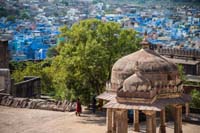 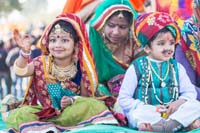  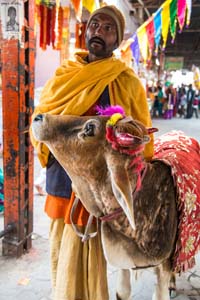 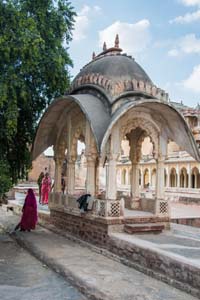 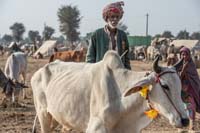 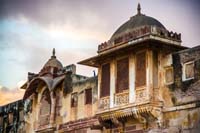 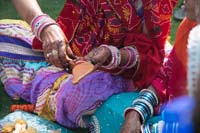 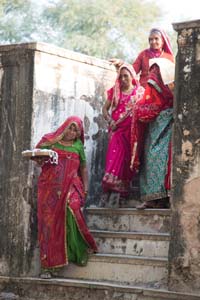 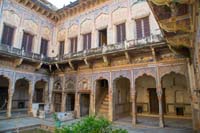 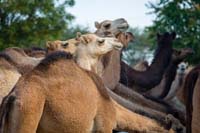     |
Deserts and Mansions Day 1: Delhi to Bikaner If you fancy a fitful night of sleep, take the overnight train That leaves the Delhi late in the evening and arrives in Bikaner at in the early morning. Arrange to have your driver pick you up there. Check in at your hotel won’t be until this afternoon, but they will let you freshen up a bit when you drop off you bags. If comfort is in order, fly or, if you are starting in Jaipur, this is about an 5 hour drive. Sitting at the northern end of the Marwar region, Bikaner is a desert stronghold which got its start as an outpost on a camel caravan route. Camels still rule the roost here, and if you are a camel aficionado, this is your Mecca. Time your visit for the full moon of Dec/Jan and you will drop into the 3 day long Camel Festival. (Check carefully on the actual dates) The beautifully preserved Junagarh Fort is in the center of town – one of the few in Rajasthan that is not on a hill. Built in 1588, this is a serious medieval fort with a sumptuous palace tucked away on the inside. There is fabulous mirror work, jali screens, and lacquer work throughout the 35 pavilions, and temples. Finish up in the museum that has a little bit of everything from miniature painting to weaponry. At about 3PM,you may want to go out to the Camel Breeding Farm to watch the camels return from their day of grazing in fields. Bikaner’s camels are known for their strength rather than speed, and this center was established to breed animals that are superior in strength, need less water, and they even have longer eyelashes to protect their eyes. It’s great fun. And you can top off the day with camel milk ice-cream. Bikaner is awash in wonderful heritage hotels. Too many to name them all, but here’s some that I do love. The most lavish is Laxmi Niwas Palace www.laxminiwaspalace.com , but be ready for a lot of hunting trophies. In the center of town – with great walks in easy reach – is the Bhanwar Niwas www.bhanwarniwas.com The staff here are really helpful and the food is superb. Splash out by booking the suite. The Bhairon Vilas www.hotelbhaironvilas.com has bright traditionally decorated rooms. The Kishan Palace is an old mansion with simple rooms www.hotelkishanpalaceheritage.com Day 2: Bikaner Set off this morning for what is probably the most unusual temple in India, the Karni Mata Temple at Deshnoke. Here, rats are revered and honored as reincarnated descendents of the saint, Karni Mata. Actually, it’s not as creepy as it sounds. The rats (kind of “pet quality”) thoughtfully stay pretty much inside the sanctuary where they are fed and rarely make a run for your feet. It’s a temple – you do have to take your shoes off, so you might want to bring a pair of socks that can be taken off and thrown away. The temple is carved out of white marble and has stunning silver doorways. After lunch, use the afternoon to walk around Bikaner. The center of the city, around the fort is full of nicely carved sandstone havelis. Most of them are privately owned, so you cannot go in, but it is a great walk. A little outside the center is the wonderful Bhandasar Jain Temple. Three stories high – and with great city views from the top, this temple is a riot of colorful painting and carved walls. In 2013, at least, the caretaker was a Hindu priest who spent a couple of hours showing us around and telling us fantastic stories. Be sure to find the nearby cow resort. Day 3: Drive to Mandawa Mandawa is the beginning of the Shekhavati Region on the outskirts of the Thar Desert, and will take about 4 hours to get there. This region boasts some of India’s most interesting and beautiful private mansions, called havelis. Starting in the mid 1800s, and ending about the time of WWl, wealthy Marwari merchants tried to out-do each other building the most beautiful house. Many lie in near ruins, but many have been rescued and restored. Some are hotels, some are in private hands of people who welcome interested explorers. They are always at least 2 stories with 2 or more courtyards. Elaborate paintings of day-to-day life or Hindu mythology cover the interior – and sometimes exterior – walls. Carvings and mirror work adorn the bedrooms. The Hotel Castle Mandawa is a destination of its own. The Maharaja of Mandawa still lives in this huge fortress home and keeps everything running smoothly. www.castlemandawa.com After lunch, you can explore a couple of the nearby havelis such as Binsidar Newatia and Murmuria. The Castle Mandawa is not the only heritage hotel in town. Be forewarned that it is where all the groups stay, so with 85 rooms it can get crowded. If you want a smaller haveli hotel, try the Hotel Mandawa Haveli www.hotelmandawa.com Or, stop at the Castle Mandawa for lunch and travel 10 km further onto the Hotel Vivaana. Day 4: Sightseeing in Shekhavati There’s plenty to keep you going all day, but your guide will have to help you decide what is the most interesting. There is so much re-building, as well as collapse going on that it changes from year to year. The main villages here are Dundlod, Jhunjhunun, and Nawalgarh, but the best havelis are not necessarily in the villages. There is a museum here – the Poddar Haveli Museum – with information on the culture and life in 19th century Shakavati. It is in a beautifully restored haveli, with photographs and costumes. Spend the night at the Vivaana Haveli. (My absolute favorite in this area!) www.vivaana.com It has been perfectly restored, authentic and yet with an eye to 21st century tastes. The rooms are quite small, but exquisite. The owners are attentive, the food is great, and the location is perfect for your explorations. N.B. – If time is not an issue, you could easily add an extra day in the Shekhavati area. It’s mostly restored havelis that you will be seeing (and they all look a lot alike), but there are plenty to keep you occupied for at least 2 days. Day 5: Drive to Nagaur Fort. This is an easy drive across flat desert on a very quiet road, but it will take about 5 hours. The Nagaur Ahhichatara Fort is one of those “drop into princely medieval Rajasthan” evocative experiences. The Getty Foundation and the Aga Khan Foundation have been restoring it they have done the job perfectly – not too much, not too little. In the month of February, there is a local cattle fair held nearby, but it’s not festive like the Pushkar Camel Fair. No one dresses up, there’s no music. Right after this, however, is a 3 day World Sufi Music Festival which is gorgeous, and draws musicians from all over the world. There are a few deluxe rooms available inside the fort. ???www. If you are there for one of the festivals, however, accommodations will be in deluxe tents –attached baths, showers, a butler – the whole works. Day 6: Drive to Phalodi An easy drive across the desert, looking for camels, bluebuck ?? and gazelles. Along the way, you might want to stop at Kichan. Between September and April, this small village hosts 20,000 demoiselle cranes that have migrated from Siberia. Even with this stop, you should be in Phalodi by lunchtime Phalodi is a very cute small traditional village that is easy to walk around in. There is a nice Jain temple and a great market area with people who really want to talk to you. There is a small heritage hotel here, the Lal Niwas. www.lalniwas.com It’s kind of dark and has a confusing floor plan, and the food wasn’t the best, but it’s got a lot of character, and it is the best in town. Day 7: Drive to Jaisalmer via Pokhran Nestled between India’s first nuclear test site and an army firing range, is a sweet little fort known as the Pokhran Balagarh Fort. It’s on the road to Jaisalmer, about 2 hours from Phalodi, and is definitely worth a stop to look around. It’s certainly not grand, but will have plenty of Indian tourists in nice Rajasthani clothing. Twelve km from Pokhran is the small, but very busy, Ramdevra Temple dedicated to a local saint, Baba Ramdev. It’s lively, full of color, and teaming with people, cows, sadhus, and Harijans ?? From here, it’s less than 2 hours to the desert fortress-city of Jaisalmer. Built in 1155, it is the second oldest fort in Rajasthan, after Chittorgarh. Some say it was part of the Silk Road, at least it was on the route between Egypt and Central Asia, and some say Marco Polo stopped off for a while. It’s huge – up until the 17th century, all 40,000 **? Inhabitants lived within the massive 30 ft thick walls. Check into your hotel and spend some time waling around. This evening, your driver can take you out to the called “Sunset Point” where there is a great view of the city lights coming on as the sun sets There are some environmental issues with the hotels here. The entire fort is sinking and, in places, is in danger of washing out. All this on account of the water and sewers systems, so the government has put a lot of restrictions on hotels to keep the tourist population down. I know – you really want to stay inside the fort! There is, however, a great alternative called the Nachana Haveli. www.nachanahaveli.com . It’s right next to the walls with great fort views from the rooftop dining room. It’s about a 15 minute walk down the mail shopping road to the gate. (Love textiles? Try Jaisalmer Handlooms) The suite on the top floor is charming. If you are there in February, you might want to work this around the Jaisalmer Desert Festival. Check with the tourist office internet site for the exact dates. If this is your plan, you might want to add a day here. Not only does the festivities take up most of the day, but the shops and some of the sights are closed. Day 8: Jaisalmer There is so much to see – just start walking. The Fort Palace is well worth the money to get in. the rooms are nicely restored with jail screens and mirror work, and there are great views from the top. Be sure to take in the Patwon-ki-Haveli and the Nathumal-ki-Haveli as well as the Jain temple. In the evening, you might want to take a sunset camel ride or watch the sunset at the Bada Bagh Chattris. Day 9: Drive to Jodhpur Depending on stops, this is a 3 to 5 hour drive on a fairly quiet road – at least till you get to outskirts of Jodhpur. There is a wealth of great hotels in Jodhpur to chose from. One of the most amazing palace hotels in all of India is the Umaid Bhawan. At one time. It was the world’s largest private residence and half of it is still occupied by the maharaja’s family. If all that sounds a bit impersonal, one of my favorite hotels here is the charming Ajit Bhawan. The public area are authentically heritage, but guests stay in newly built local style bungalows. The Pal Haveli hotel – a restored haveli – is located in the center of town and is very nice. One of the best meals I ever had in India was in their roof top restaurant. Day 10: Jodhpur It will take at least a half a day to do the mighty Mehrengarh ?? fort justice. Day 11: Fly back to Delhi and connect out on your international flights, or spend some time in Delhi. |
